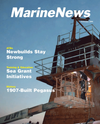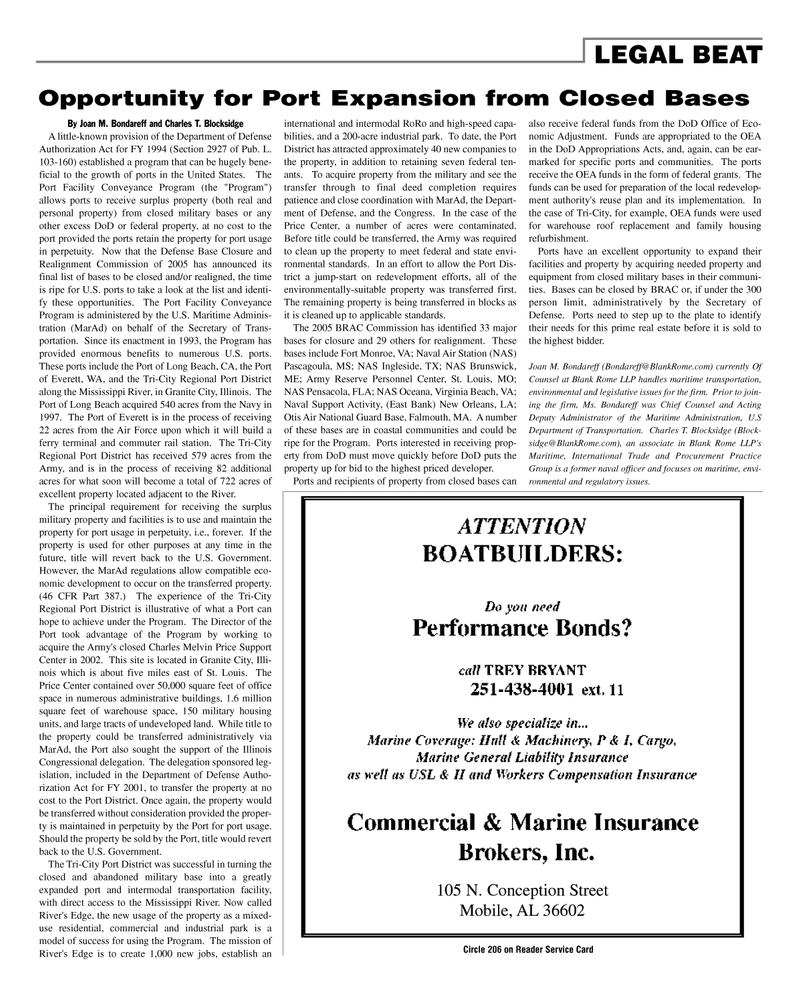
Page 15: of Marine News Magazine (February 2006)
The Training & Education Edition
Read this page in Pdf, Flash or Html5 edition of February 2006 Marine News Magazine
By Joan M. Bondareff and Charles T. Blocksidge
A little-known provision of the Department of Defense
Authorization Act for FY 1994 (Section 2927 of Pub. L. 103-160) established a program that can be hugely bene- ficial to the growth of ports in the United States. The
Port Facility Conveyance Program (the "Program") allows ports to receive surplus property (both real and personal property) from closed military bases or any other excess DoD or federal property, at no cost to the port provided the ports retain the property for port usage in perpetuity. Now that the Defense Base Closure and
Realignment Commission of 2005 has announced its final list of bases to be closed and/or realigned, the time is ripe for U.S. ports to take a look at the list and identi- fy these opportunities. The Port Facility Conveyance
Program is administered by the U.S. Maritime Adminis- tration (MarAd) on behalf of the Secretary of Trans- portation. Since its enactment in 1993, the Program has provided enormous benefits to numerous U.S. ports.
These ports include the Port of Long Beach, CA, the Port of Everett, WA, and the Tri-City Regional Port District along the Mississippi River, in Granite City, Illinois. The
Port of Long Beach acquired 540 acres from the Navy in 1997. The Port of Everett is in the process of receiving 22 acres from the Air Force upon which it will build a ferry terminal and commuter rail station. The Tri-City
Regional Port District has received 579 acres from the
Army, and is in the process of receiving 82 additional acres for what soon will become a total of 722 acres of excellent property located adjacent to the River.
The principal requirement for receiving the surplus military property and facilities is to use and maintain the property for port usage in perpetuity, i.e., forever. If the property is used for other purposes at any time in the future, title will revert back to the U.S. Government.
However, the MarAd regulations allow compatible eco- nomic development to occur on the transferred property. (46 CFR Part 387.) The experience of the Tri-City
Regional Port District is illustrative of what a Port can hope to achieve under the Program. The Director of the
Port took advantage of the Program by working to acquire the Army's closed Charles Melvin Price Support
Center in 2002. This site is located in Granite City, Illi- nois which is about five miles east of St. Louis. The
Price Center contained over 50,000 square feet of office space in numerous administrative buildings, 1.6 million square feet of warehouse space, 150 military housing units, and large tracts of undeveloped land. While title to the property could be transferred administratively via
MarAd, the Port also sought the support of the Illinois
Congressional delegation. The delegation sponsored leg- islation, included in the Department of Defense Autho- rization Act for FY 2001, to transfer the property at no cost to the Port District. Once again, the property would be transferred without consideration provided the proper- ty is maintained in perpetuity by the Port for port usage.
Should the property be sold by the Port, title would revert back to the U.S. Government.
The Tri-City Port District was successful in turning the closed and abandoned military base into a greatly expanded port and intermodal transportation facility, with direct access to the Mississippi River. Now called
River's Edge, the new usage of the property as a mixed- use residential, commercial and industrial park is a model of success for using the Program. The mission of
River's Edge is to create 1,000 new jobs, establish an international and intermodal RoRo and high-speed capa- bilities, and a 200-acre industrial park. To date, the Port
District has attracted approximately 40 new companies to the property, in addition to retaining seven federal ten- ants. To acquire property from the military and see the transfer through to final deed completion requires patience and close coordination with MarAd, the Depart- ment of Defense, and the Congress. In the case of the
Price Center, a number of acres were contaminated.
Before title could be transferred, the Army was required to clean up the property to meet federal and state envi- ronmental standards. In an effort to allow the Port Dis- trict a jump-start on redevelopment efforts, all of the environmentally-suitable property was transferred first.
The remaining property is being transferred in blocks as it is cleaned up to applicable standards.
The 2005 BRAC Commission has identified 33 major bases for closure and 29 others for realignment. These bases include Fort Monroe, VA; Naval Air Station (NAS)
Pascagoula, MS; NAS Ingleside, TX; NAS Brunswick,
ME; Army Reserve Personnel Center, St. Louis, MO;
NAS Pensacola, FLA; NAS Oceana, Virginia Beach, VA;
Naval Support Activity, (East Bank) New Orleans, LA;
Otis Air National Guard Base, Falmouth, MA. A number of these bases are in coastal communities and could be ripe for the Program. Ports interested in receiving prop- erty from DoD must move quickly before DoD puts the property up for bid to the highest priced developer.
Ports and recipients of property from closed bases can also receive federal funds from the DoD Office of Eco- nomic Adjustment. Funds are appropriated to the OEA in the DoD Appropriations Acts, and, again, can be ear- marked for specific ports and communities. The ports receive the OEA funds in the form of federal grants. The funds can be used for preparation of the local redevelop- ment authority's reuse plan and its implementation. In the case of Tri-City, for example, OEA funds were used for warehouse roof replacement and family housing refurbishment.
Ports have an excellent opportunity to expand their facilities and property by acquiring needed property and equipment from closed military bases in their communi- ties. Bases can be closed by BRAC or, if under the 300 person limit, administratively by the Secretary of
Defense. Ports need to step up to the plate to identify their needs for this prime real estate before it is sold to the highest bidder.
Joan M. Bondareff ([email protected]) currently Of
Counsel at Blank Rome LLP handles maritime transportation, environmental and legislative issues for the firm. Prior to join- ing the firm, Ms. Bondareff was Chief Counsel and Acting
Deputy Administrator of the Maritime Administration, U.S
Department of Transportation. Charles T. Blocksidge (Block- [email protected]), an associate in Blank Rome LLP's
Maritime, International Trade and Procurement Practice
Group is a former naval officer and focuses on maritime, envi- ronmental and regulatory issues.
LEGAL BEAT 105 N. Conception Street
Mobile, AL 36602
Circle 206 on Reader Service Card
Opportunity for Port Expansion from Closed Bases
FEBRUARY MN2006 2(9-16).qxd 2/3/2006 3:43 PM Page 15

 14
14

 16
16
